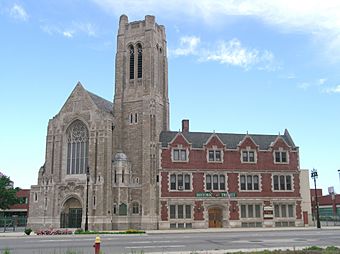Historic Trinity Lutheran Church facts for kids
|
Trinity Evangelical Lutheran Church Complex
|
|
 |
|
| Location | 1345 Gratiot Avenue Detroit, Michigan, United States |
|---|---|
| Built | 1927 |
| Architect | Bernard C. Wetzel, W. E. N. Hunter |
| Architectural style | Gothic Revival, Tudor Revival |
| NRHP reference No. | 83000897 |
Quick facts for kids Significant dates |
|
| Added to NRHP | February 10, 1983 |
The Historic Trinity Lutheran Church is a special church in downtown Detroit, Michigan. It's part of the Trinity Evangelical Lutheran Church complex. This beautiful building is located at 1345 Gratiot Avenue. It was recognized as a Michigan State Historic Site in 1981. Later, in 1983, it was added to the National Register of Historic Places. This means it's an important historical place for the whole country! The current pastor is Rev. Darryl L. Andrzejewski.
History
Early Beginnings
The Trinity church community started way back in 1850. It began when some members left another church, St. Matthew's Lutheran Church. These members were German-speaking. They first held their services in a small chapel. This chapel was located at the corner of Jefferson and Hastings.
Soon, the group bought another chapel. They moved it to Rivard and Larned streets. But this building quickly became too small for everyone. So, in 1866, the church built a new brick building. It was located at Gratiot and Rivard. This area was perfect for Trinity. Many German families lived there, especially near the Eastern Market Historic District.
Around this time, Trinity helped start many new things. They began schools, missions, and other churches. In fact, 132 Lutheran churches in southeast Michigan can trace their beginnings back to Trinity.
A New Church Building
In 1905, the church built a new school and a social hall. These were close to the main church building. However, the area around Trinity began to change. Many families moved away from downtown. Also, fewer new German immigrants arrived. Because of these changes, Trinity started offering services in English. They still had services in German too.
In the late 1920s, Trinity thought about fixing up its 1866 church. But then, a church member named Charles Gauss stepped forward. He offered to pay for a brand new church building! The old church was taken down. The first stone of the current church was placed in 1929. The new church was officially opened on February 15, 1931.
Staying in Downtown Detroit
After World War II, many people moved out of downtown Detroit. They went to live in the suburbs. Because of this, many churches in Detroit lost members. Trinity was one of them. However, the pastor at that time, Gilbert Theodore Otte, was determined. He wanted the church to stay right in the downtown area.
The city of Detroit recognized the 1931 church building as important history in 1979. The state of Michigan did the same in 1982. Then, in 1983, it was added to the National Register of Historic Places.
Even with this recognition, the number of church members went down. In 1981, there were only 112 members. But in 1983, Rev. David Eberhard became the new pastor. He stayed until 2015. He started new programs that helped the church grow. In just five years, the number of members tripled! The church is still a very important place for Lutherans in Detroit. In 2012, it had over 2100 members. The church now operates under the name Historic Trinity. It is part of the Lutheran Church–Missouri Synod.
See also
 In Spanish: Iglesia Luterana Histórica de la Trinidad para niños
In Spanish: Iglesia Luterana Histórica de la Trinidad para niños



